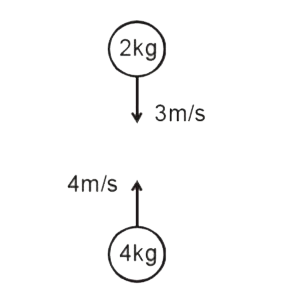Two spheres made of clay of masses 'm1' and 'm2' moving along a straight line in the same direction collide with each other. Their velocities just before collision are 'u1' and 'u2' respectively. After collision, they stick together and move with teh same velocity, in the same direction, along the straight line. Find the velocity with which they move together.
Find the masses of two spheres made of clay.
Find the velocities of the spheres before collision from the given data.
Find the velocity of the spheres after collision.
Here, do the two spheres stick together and move with the same velocity, in the same direction, along the straight line.
Does it mean that they have a common velocity?
Then, find the law of conservation of momentum.
Using data, total momentum of bodies before collision is equal to total momen-tum after collision in a given system.
So, m1u1+m2u2=m1v1+m2v2 (1)
Given, that, v1=v2=v (common velocity)
Find the value of 'v' from equation (1).
Topper's Solved these Questions
- BOOK - PEARSON IIT JEE FOUNDATIONCHAPTER - DYNAMICSEXERCISE - EXAMPLE11videos
DYNAMICS
- BOOK - PEARSON IIT JEE FOUNDATIONCHAPTER - DYNAMICSEXERCISE - TEST YOUR CONCEPTS(VERY SHORT ANSWER TYPE QUESTIONS)31videos
DYNAMICS
- BOOK - PEARSON IIT JEE FOUNDATIONCHAPTER - DYNAMICSEXERCISE - Level 221videos
DYNAMICS
- BOOK - PEARSON IIT JEE FOUNDATIONCHAPTER - CHEMICAL EFFECTS OF ELECTRIC CURRENTEXERCISE - COMPETITION CORNER (MCQ)48videos
CHEMICAL EFFECTS OF ELECTRIC CURRENT
- BOOK - PEARSON IIT JEE FOUNDATIONCHAPTER - ELECTRICITYEXERCISE - CONCEPT APPLICATION (Level 3)10videos
ELECTRICITY
Similar Questions
Two balls are moving towards each other on a vertical line collides with each other as shown. Find their velocities just after collision.
 View Solution
View SolutionTwo balls of masses m and 2m moving in opposite directions collide head on elastically with velocities v and 2v. Find their velocities after collision.
View Solution
Knowledge Check
- Question 1 - Select One
Two equal masses m1 and m2 moving along the same straight line with velocites +3m/s and −5m/s respectively collide elastically. Their velocities after the collision will be respectively.
A+4m/s for bothB−3m/sand+5m/sC−4m/sand+4m/sD−5m/sand+3m/s - Question 2 - Select One
Two particles of mass m and 2 m moving in opposite directions collide elastically with velocities v and 2v. Find their velocities after collision.
A0, 3vB1, 3vC0, 1vD0, 4v - Question 3 - Select One
A body of mass 1kg is moving along a straight line with a velocity of 1m/s. The external force acting in the body is
A1NB1 dyneC1JDzero
A railway carriage of mass 10gand200g are moving along the same line in the same direction with velocities of 2m/sand1m/s respectively. They collide and after the collison, the first object moves with a velocity of 1.67m/s in the same direction. Determine the velocity of the second object.
View SolutionTwo particles of masses m and 2m moving in opposite directions collide elastically with velocity 2v and v, respectiely. Find their velocities after collision.
 View Solution
View SolutionTwo objects of masses 100g and 200g are moving along the same line in the same line in the same direction with velocities of 2m/s and 1m/s, respectively. They collide and after the collison, the first object moves at a velocity of 1.67m/s in the same direction. Determine the velocity of the second object.
View SolutionConsider objects of masses m1andm2 moving initially along the same straight line with velocities u1andu2 respectively. Considering a perfectly elastic collision (with u1>u2) derive expressions for their velocities after collision.
View SolutionTwo object A and B are moving along the same straight line in opposite directions with velocities 10m/s and 5m/s respectively. They collide during which they stick to each other. If mass of A is 1.5kg and mass of B is 1kg, what is the velocity of the combinations?
View Solution

